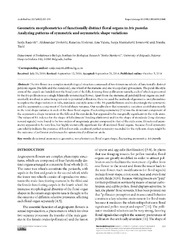Приказ основних података о документу
Geometric morphometrics of functionally distinct floral organs in Iris pumila: Analyzing patterns of symmetric and asymmetric shape variations
| dc.creator | Radović, Sanja | |
| dc.creator | Urošević, Aleksandar | |
| dc.creator | Hočevar, Katarina | |
| dc.creator | Vuleta, Ana | |
| dc.creator | Manitašević Jovanović, Sanja | |
| dc.creator | Tucić, Branka | |
| dc.date.accessioned | 2017-11-23T11:30:36Z | |
| dc.date.available | 2017-11-23T11:30:36Z | |
| dc.date.issued | 2017 | |
| dc.identifier.issn | 0354-4664 | |
| dc.identifier.uri | http://www.doiserbia.nb.rs/Article.aspx?ID=0354-46641600086R | |
| dc.identifier.uri | http://www.serbiosoc.org.rs/arch/index.php/abs/article/view/838 | |
| dc.identifier.uri | https://radar.ibiss.bg.ac.rs/handle/123456789/2772 | |
| dc.description.abstract | The Iris flower is a complex morphological structure composed of two trimerous whorls of functionally distinct petaloid organs (the falls and the standards), one whorl of the stamens and one tricarpellary gynoecium. The petal-like style arms of the carpels are banded over the basal part of the falls, forming three pollination tunnels, each of which is perceived by the Iris pollinators as a single bilaterally symmetrical flower. Apart from the stamens, all petaloid floral organs are preferentially involved in advertising rewards to potential pollinators. Here we used the methods of geometric morphometrics to explore the shape variation in falls, standards and style arms of the Iris pumila flowers and to disentangle the symmetric and the asymmetric component of the total shape variance. Our results show that symmetric variation contributes mostly to the total shape variance in each of the three floral organs. Fluctuating asymmetry (FA) was the dominant component of the asymmetric shape variation in the falls and the standards, but appeared to be marginally significant in the style arms. The values of FA indexes for the shape of falls (insects' landing platforms) and for the shape of standards (long-distance reward signals) were found to be two orders of magnitude greater compared to that of the style arms. Directional asymmetry appeared to be very low, but highly statistically significant for all analyzed floral organs. Because floral symmetry can reliably indicate the presence of floral rewards, an almost perfect symmetry recorded for the style arm shape might be the outcome of pollinator preferences for symmetrical pollination units. | en |
| dc.relation | info:eu-repo/grantAgreement/MESTD/Basic Research (BR or ON)/173007/RS// | |
| dc.rights | openAccess | |
| dc.rights.uri | https://creativecommons.org/licenses/by-nc-nd/4.0/ | |
| dc.source | Archives of Biological Sciences | |
| dc.subject | Directional asymmetry | |
| dc.subject | Floral organ shape | |
| dc.subject | Fluctuating asymmetry | |
| dc.subject | Geometric morphometrics | |
| dc.subject | Iris pumila | |
| dc.title | Geometric morphometrics of functionally distinct floral organs in Iris pumila: Analyzing patterns of symmetric and asymmetric shape variations | en |
| dc.type | article | |
| dc.rights.license | BY-NC-ND | |
| dcterms.abstract | Вулета, Aна; Туцић, Бранка; Хочевар, Катарина; Маниташевић Јовановић, Сања; Урошевић, Aлександар; Радовић, Сања; | |
| dc.rights.holder | © 2017 by the Serbian Biological Society | |
| dc.citation.issue | 2 | |
| dc.citation.volume | 69 | |
| dc.description.other | Archives of Biological Sciences (2017), 69(2): 223-231 | |
| dc.identifier.doi | 10.2298/ABS160912086R | |
| dc.identifier.scopus | 2-s2.0-85019666094 | |
| dc.identifier.wos | 000402556600003 | |
| dc.citation.apa | Radović, S., Urošević, A., Hočevar, K., Vuleta, A., Manitašević-Jovanović, S., & Tucić, B. (2017). Geometric morphometrics of functionally distinct floral organs in Iris pumila: Analyzing patterns of symmetric and asymmetric shape variations. Archives of Biological Sciences, 69(2), 223–231. | |
| dc.citation.vancouver | Radović S, Urošević A, Hočevar K, Vuleta A, Manitašević-Jovanović S, Tucić B. Geometric morphometrics of functionally distinct floral organs in Iris pumila: Analyzing patterns of symmetric and asymmetric shape variations. Arch Biol Sci. 2017;69(2):223–31. | |
| dc.citation.spage | 223 | |
| dc.citation.epage | 231 | |
| dc.type.version | publishedVersion | en |
| dc.identifier.fulltext | https://radar.ibiss.bg.ac.rs/bitstream/id/3454/bitstream_3454.pdf | |
| dc.citation.rank | M23 |

